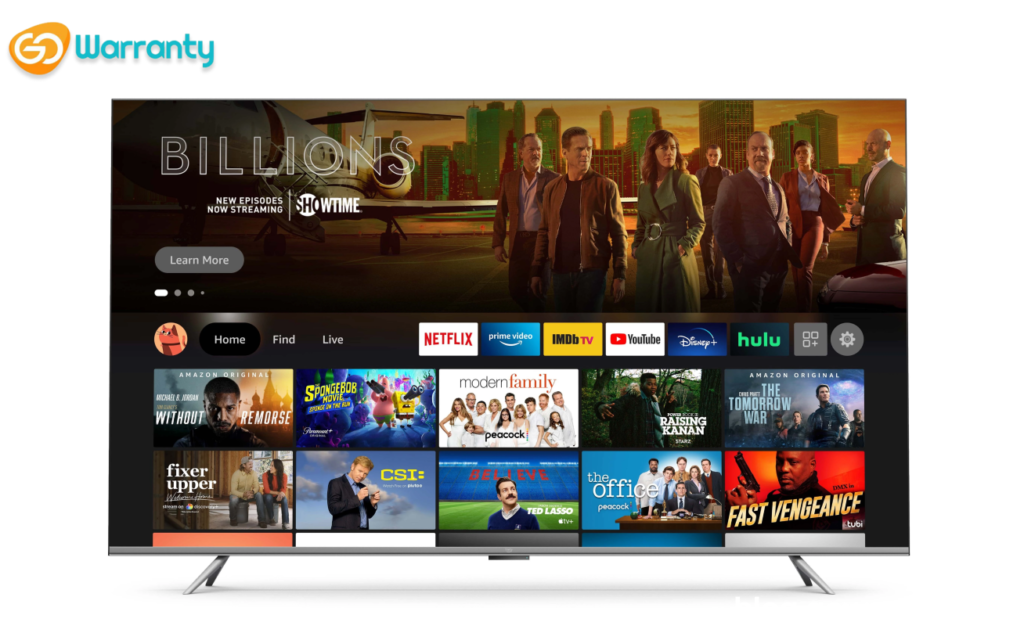The Amazon Fire TV Omni Series is a low-cost, entry-level 4k television. It’s one of the first Amazon-branded TVs, along with the Amazon Fire TV 4-Series. It improves marginally on the 4-Series, with Dolby Vision support on larger sizes and better build quality. It’s ideal for a dark room, with good black uniformity and contrast. As long as there isn’t a lot of natural light, it’s bright enough to handle glare in most rooms. It has a wide range of streaming apps and can remove judder from any source, which is unusual for a 60Hz TV. The remote has built-in voice controls, and the TV has microphones for hands-free operation. Unfortunately, it shares many of the same flaws as the 4-Series; it has disappointing out-of-the-box accuracy and only a basic white balance calibration system. It also has a slow response time, which causes blur behind fast-moving objects.
Design
The Amazon Fire TV Omni Series 65-inch and 75-inch models have a more premium design than the Amazon Fire TV 4-Series, with such a metallic silver finish and very thin bezels. The smaller sizes have a less-premium black plastic finish, with the same thin bezels as the 65-inch model. The back is plain, but the inputs are on the side and easy to reach when the TV is wall-mounted. There is no cable management, which is a letdown.
Stand
The stand is simple, but it adequately supports the TV. The 65″ and 75″ models are more upscale than the Amazon Fire TV 4-Series. The smaller sizes have a similar stand, but it is glossy black. The 65″ stand has a footprint of 49.3″ x 13.9″. The feet raise the TV 2.5″ from the table to the bottom of the IR receiver, or 3.5″ to the bottom of the screen, allowing most soundbars to be placed in front of it without blocking the screen.
Picture Quality
Contrast
The Amazon Fire TV Omni Series has a high contrast ratio, resulting in deep blacks in dim lighting. Although contrast varies between individual units, these results are typical for a VA panel. Unfortunately, there is no local dimming feature to improve contrast.
SDR Brightness
In SDR, the Amazon Fire TV Omni Series has a reasonable peak brightness. The brightness varies very little between scenes, which is great, but it’s bright enough to overcome glare in most rooms. These measurements were taken after calibration in the ‘Movie’ Picture Mode with the Backlight set to its maximum, Contrast set to ’50,’ Gamma set to ‘1,’ Colour Saturation set to ’45,’ and Colour Temperature set to ‘Warm.’
HDR Brightness
In HDR, the Amazon Fire TV Omni Series has a low peak brightness. It’s nowhere near bright enough to provide a memorable HDR experience. Dark scenes are slightly over-brightened, but most scenes are displayed at the proper brightness levels. Unfortunately, there is a sharp cutoff at the peak brightness of the TV, resulting in the loss of fine details in bright scenes. Peak brightness varies very little between scenes, which is fantastic.
Viewing Angle and Reflections
Unfortunately, as one would expect from a VA panel, the Amazon Fire TV Omni Series has poor viewing angles. If your seating arrangement is directly in front of the TV, this is usually not an issue, but if you have side seating or a large living room, the image appears washed out to those sitting to the sides of the TV. If you want something with wide viewing angles, the TCL 4 Series/S446 2021 65-inch model has an IPS panel.
The Amazon Fire TV Omni Series handles reflections well. Although the semi-gloss finish reduces the intensity of direct reflections, it does cause some smearing across the display. However, it is bright enough that glare will not be an issue for most people.

Motion
Response Time
The Amazon Fire TV Omni Series responds quickly. Transitions to and from near-dark colours are significantly slower, as with most VA TVs, resulting in a longer trail behind fast-moving objects. It’s commonly referred to as black smearing. Unfortunately, the Amazon Fire Omni Series dims the backlight with pulse-width modulation, and there is noticeable flicker at all backlight levels below the maximum. This flicker frequency is low enough just to bother some people and causes motion duplications.
Motion Interpolation
Optional motion interpolation is available on the Amazon Fire TV Omni Series, which can improve the appearance of low frame rate content. Overall, it’s adequate, but it struggles with fast-paced content. There are visible artefacts and haloing around some content, and the video is choppy when the camera moves.
Inputs
Only in the ‘Game’ Picture Mode does the Amazon Fire TV Omni Series have fantastic low input lag. Input lag is unacceptably high outside of ‘Game’ Mode, including in ‘PC’ Mode. Unfortunately, even in ‘PC’ Mode, the Amazon Fire TV Omni Series cannot display proper 4:4:4 chroma with any supported resolution, so text appears blurry from a PC.
With both of the new consoles, this TV only supports the basic 4k @ 60Hz formats. It does not support advanced gaming features, but when you start playing a game from a supported source, it automatically switches to ‘Game’ Mode. The Amazon Fire TV Series is advertised as supporting HDMI 2.1, but the ports do not support bandwidth above HDMI 2.0.
Sound Quality
The frequency response of the Amazon Fire TV Omni Series is average. It has a very high low-frequency extension (LFE), which results in almost no bass response, as well as no thump or rumble. It has a fairly balanced sound profile above the LFE, so most dialogue is clear. It gets quite loud, but there is some compression at maximum volume.
Unfortunately, the distortion performance of this TV is mediocre. At maximum volume, there is significantly more distortion than on the Amazon Fire TV 4-Series, which is noticeable and does not sound good. At a moderate listening level, it’s not too bad, and not everyone will hear it.

